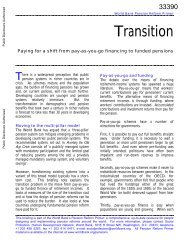Financial Sector Development in Africa: Opportunities ... - World Bank
Financial Sector Development in Africa: Opportunities ... - World Bank
Financial Sector Development in Africa: Opportunities ... - World Bank
You also want an ePaper? Increase the reach of your titles
YUMPU automatically turns print PDFs into web optimized ePapers that Google loves.
Introduction 3<br />
challenges—loom even more prom<strong>in</strong>ently <strong>in</strong> agricultural and rural<br />
f<strong>in</strong>ance than <strong>in</strong> other sectors. Foster<strong>in</strong>g competition and the adoption of<br />
technology-driven f<strong>in</strong>ancial <strong>in</strong>novation is thus even more important <strong>in</strong><br />
agriculture than it is <strong>in</strong> other sectors. The authors show how agribus<strong>in</strong>ess,<br />
rural banks and credit unions, and small agricultural producers can adopt<br />
tactical solutions to catalyze the power of big commercial banks and<br />
private <strong>in</strong>vestors. They provide several examples of successful <strong>in</strong>novation<br />
<strong>in</strong> the region that <strong>in</strong>volved new products and new providers, new delivery<br />
channels, and new connections among different segments of the f<strong>in</strong>ancial<br />
system and the agricultural sector. However, they also po<strong>in</strong>t out that<br />
f<strong>in</strong>ance is only part of the solution and note that other major challenges<br />
<strong>in</strong> the policy and bus<strong>in</strong>ess environments and support<strong>in</strong>g <strong>in</strong>frastructure<br />
still rema<strong>in</strong> to be overcome.<br />
Part II: Lengthen<strong>in</strong>g Contracts<br />
The challenges <strong>in</strong> long-term f<strong>in</strong>ance loom as large as those <strong>in</strong>volved <strong>in</strong><br />
expand<strong>in</strong>g the outreach of the f<strong>in</strong>ancial system. <strong>Africa</strong> faces many longterm<br />
<strong>in</strong>vestment needs, but lacks the necessary resources, markets, and<br />
products to satisfy these needs. This part of the book takes a detailed look<br />
at one of the areas where long-term f<strong>in</strong>ance is needed—hous<strong>in</strong>g f<strong>in</strong>ance.<br />
In chapter 4, Simon Walley takes stock of hous<strong>in</strong>g f<strong>in</strong>ance <strong>in</strong> <strong>Africa</strong>. He<br />
documents the sizable need for additional hous<strong>in</strong>g <strong>in</strong> many <strong>Africa</strong>n countries,<br />
based on these countries’ cont<strong>in</strong>uous population growth and an<br />
ongo<strong>in</strong>g urbanization trend. The current lack of hous<strong>in</strong>g f<strong>in</strong>ance has contributed<br />
to the urban sprawl with largely <strong>in</strong>formal, poor-quality hous<strong>in</strong>g.<br />
He describes different hous<strong>in</strong>g f<strong>in</strong>ance regimes across <strong>Africa</strong>, their fund<strong>in</strong>g<br />
structure, and their ref<strong>in</strong>anc<strong>in</strong>g schemes. He po<strong>in</strong>ts to the major<br />
constra<strong>in</strong>ts for expand<strong>in</strong>g hous<strong>in</strong>g f<strong>in</strong>ance <strong>in</strong> <strong>Africa</strong>: the lack of affordable<br />
hous<strong>in</strong>g, the lack of capacity and the high risk aversion of lenders, the<br />
adverse macroeconomic environment, and the lack of land titl<strong>in</strong>g.<br />
Part III: Safeguard<strong>in</strong>g F<strong>in</strong>ance<br />
As <strong>Africa</strong>n f<strong>in</strong>ancial systems deepen and broaden, new challenges arise for<br />
regulators and supervisors across <strong>Africa</strong>. In chapter 5, Michael Fuchs,<br />
Thomas Losse-Mueller, and Mikaio Witte discuss the repercussions of<br />
regulatory reforms <strong>in</strong> Europe and North America for <strong>Africa</strong>n regulators as<br />
well as local challenges. They compare and contrast key elements of the<br />
<strong>in</strong>ternational reform discussion with the priorities for reform <strong>in</strong> <strong>Africa</strong> and







